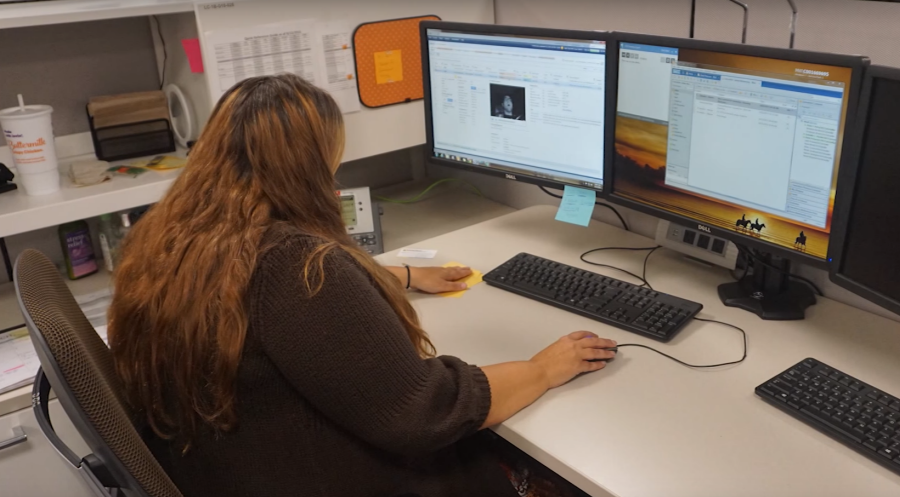Waking up groggy truck drivers from 17,000 KM away
Truck drivers around the world are monitored and even woken up remotely in Caterpillar’s Peoria headquarters.
Caterpillar’s sleep fatigue center uses face recognition software to observe drivers who may start to nod off or become distracted. Clips of the drivers who are either distracted or groggy arrive from locations ranging from northern Alberta to Western Australia, over 17,000 KM away.
MINING.com discussed the sleep management system with Mike Hatfield, who looks after business development at Caterpillar. MINING.com toured the facility in the fall of 2015.
Transcript has been edited for brevity and clarity.
MINING.com: What do you do at Caterpillar?
Hatfield: I work in the analytics and innovation group focused on identifying new opportunities around sustainability and safety.
MINING.com: Can you tell me something about safety solutions?
Hatfield: So Caterpillar decided to take a different approach to helping customers improve safety on the job site, more of a solutions approach—looking at behaviour and culture and systems and processes—not just technologies.
MINING.com: What has been your involvement with fatigue management?
Hatfield: I was part of the team that helped to take the solutions approach. How can we take different technologies to improve safety on the job site.
MINING.com: Why is fatigue management important at a mine site?
Hatfield: Because it is a 24/7 operation. And we find that our customers are really trying to fight their body’s natural tendencies to operate in different modes. The shift schedules are demanding. The work is repetitive. There are issues trying to keep people engaged in the work that they are doing.
MINING.com: What are the solutions for keeping people engaged?
Hatfield: We have ways to get visibility to the risk on the job site. That’s the driver safety system, which can give us insight on where these issues are occurring. We also decided to take a predictive approach to it as well, which is the CatSmart band, and that gives us visibility to when folks might have alertness levels throughout the day.
MINING.com: Can you tell me about the business you partnered with out of Australia?
Hatfield: Caterpillar partnered with Seeing Machines on technology they had for being able to sense fatigue and distraction using the camera in the cab.
MINING.com: How does the machine work?
Hatfield: The system has a camera and a lighting system that allows us to have a view of the operator behind the equipment and algorithms in the camera that can detect eye closure or the gaze of the operator where they are looking in the vehicle or outside and with that information they are able to detect when a eye closure or fatigue or distraction event has occurred and to be able to alert the operator and provide remote alerting into fleet monitoring centers.
MINING.com: What do you do with this data? How do you take action when you find someone who may be distracted or fatigued?
Hatfield: So that data we provide back to the customer in terms of an active alert, intervention. It is part of a fatigue intervention plan. We work with the customer to when these events happen, when a fatigue event happens, when a distraction event happens. The first time, the second time, the third time. What is the escalation procedure? How do we want to deal with these issues? Do we need to take a swap with an operator? Do we need to take a break? Do we need to look at the shift schedule that’s driving these types of outcomes? So we try to take a holistic approach to not only what do we do when an event takes place but what do we do upstream to prevent those events from occurring.
MINING.com: So the work is consultative in a way? You are working with the client and saying that there may be a distraction event or fatigue event that happened but these would be some of the actions you would be able to take.
Hatfield: Correct. It is a systems approach looking at the processes, looking at the shift schedule, the diet, the exercise, the sleep. It is more of a holistic approach to managing fatigue on the job.
MINING.com: You have a monitoring system in Peoria for monitoring fatigue?
Hatfield: Within Caterpillar’s fleet, there is a fleet monitoring centre. We have safety advisors that are watching when these events occur. That video clip is sent to the safety advisors and they can classify those events to make sure the computer made the appropriate determination, whether it was a fatigue or distraction event then they will make contact with the site, the supervisor, the shift manager. They will talk to them about the event and follow this fatigue intervention plan with what happens next.
MINING.com: What features are coming up?
Hatfield: So Caterpillar spends a great into making sure we have efficient equipment with maximum productivity and uptime. but we understand that the operator might have issues that give variability to that. So what we are trying to do is take an approach where let’s link the operator to the productivity and uptime of the equipment and let’s look at how the equipment is behaving or how fatigued operator is impacting the piece of equipment.
{{ commodity.name }}
{{ post.title }}
{{ post.date }}





7 Comments
Restless Boomers
Big brother is watching you.
Brian Rumble
Safety,safety,safety. How about the industry starts paying drivers a living wage so they can sleep when they’re tired and not be forced to chase the next mile. It’ll be two birds with one stone. The driver shortage(better pay attracts emplpyees)will dissipate and safety will improve. Pay is a major factor in being a safe operator,it’s time the government and industry take a serious look at it.
timH
Where is there a driver shortage at the moment?
J. D. Baker
Sleep, schedules vs body clock, and attention/distracted driving are key. Higher pay doesn’t help drivers who are easily distracted/bored, sleep deprived (using too much of their downtime for something other than exercise and sleep).
This may be “harsh”, but driving is not some rare skill with high entry bar – especially given the improved ergonomics, gear and technology in most of these trucks now. There is no shortage of potential qualified/trainable drivers vs. available jobs.
Higher wages will only further accelerate plans and incentive to remove humans from the vehicle. Driverless vehicles are already here. For example, over next two decades in USA long haul commercial trucking will be increasingly dominated by automation and displacement of human drivers.
Andrey Karpenkov
Driverless trucks and robots is that you gonna to get from the industry first.
The Real John Smith
I need this for when my wife is telling me about her day.
the observer
The only thing that matters, is profit for the shareholders. Full time employees are expensive, have paid holidays, and have HSE backup, using contractors, as Casuals, is a lot cheaper , no rights, no complaints, no paid holidays, if you don’t like it, you know where to go, and you are part of Collin Barnett’s “Flexible Workforce” or the slave labor economy.